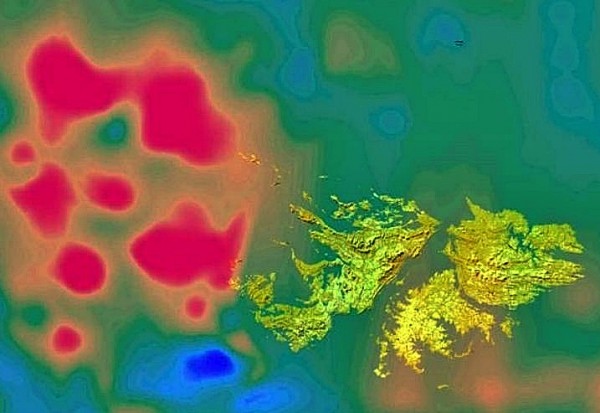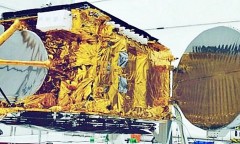By Arthur Dominic J. Villasanta , | May 07, 2017

Probable Falklands asteroid impact crater (in red) to the northwest of the Falkland Islands (in yellow).
A multinational team of scientists has claimed the discovery of what might be the crater that triggered the greatest mass extinction event in Earth's history.
A massive impact crater measuring 250 kilometers was discovered off the northwest coast of the Falkland Islands in the South Atlantic Ocean. The scientists said the Falklands Crater, which has eroded greatly over time due to the effect of wave action, appears to date to between 270 and 250 million years ago.
Like Us on Facebook
If this initial estimate is borne out by subsequent investigations, the immense asteroid strike that gouged out the Falklands Crater will become the prime candidate that caused the Permian-Triassic (P-Tr or P-T) extinction event, more popularly known as The Great Dying, in which up to 96% of all marine species and 70% of terrestrial vertebrate species on Earth were wiped-out.
The Great Dying, which was heretofore associated with the eruption of a massive volcano system in Siberia, remains the Earth's most severe known extinction event. It's the only known event that led to a mass extinction of insects.
Some 57% of all families and 83% of all genera became extinct because of The Great Dying. Since so much biodiversity was destroyed, the recovery of life took significantly longer than after any other extinction event, possibly up to 10 million years.
The team from the U.S., Argentina and Paraguay looked at various aspects of the crater, including gravity anomalies and seismic reflection, which enabled them to estimate sub-surface properties.
Their findings were consistent with other impact craters, with certain features being "very similar to that of the Chicxulub multi-ring impact structure."
The immense asteroid that struck in the waters off the Yucatan Peninsula in Mexico caused the Cretaceous-Paleogene extinction event 66 million years ago in which 75% of plant and animal species on Earth suddenly became extinct, including the dinosaurs.
This crater is more than 180 kilometers in diameter and 20 km in depth, and penetrates well into the continental crust of the region by about 10-30 km.
Scientists that probed the Falklands Crater found there was a large magnetic anomaly, suggesting significant variation in rocks at the site, as well as gravitational variations "typical of very large impact structures."
They believe the crater appears to date to the Late Paleozoic Era, around the same time as the Great Dying. They believe the crater dates to between 270 and 250 million years ago, but say more investigations are needed to confirm this.
"Future drilling in this basin is a must" they wrote in a paper published in the scientific journal, Terra Nova.
"If confirmed as a site of impact, then this structure would be one of the largest known impact structures on Earth."
The presence of a massive crater in the Falklands was first proposed by Michael Rampino, a professor in New York University, in 1992.
Rampino said he noticed similarities with the Chicxulub crater in Mexico and began to investigate. Decades later, a team of scientists, including Rampino, returned to the area to perform an "exhaustive search for additional new geophysical information" that would indicate the presence of an impact crater.
Their findings published in Terra Nova suggest the huge circular depression just northwest of the islands is the result of the massive impact of an asteroid or meteorite. The basin, which is now buried under sediments, measures over 250 kilometers in diameter.
"If the proposed crater turns out to be 250 million years old, it could correlate with the largest mass extinction ever -- the Permian extinctions -- which wiped out more than 90 percent of all species," said Rampino.
"If the Falklands basin is really an impact crater, and it has some of the most telling features, then it is one of the largest known."
The researchers also included Max C.L. Rocca of Argentina's Planetary Society and Paraguay-based geologist Jaime Báez Presser.
-
Use of Coronavirus Pandemic Drones Raises Privacy Concerns: Drones Spread Fear, Local Officials Say

-
Coronavirus Hampers The Delivery Of Lockheed Martin F-35 Stealth Fighters For 2020

-
Instagram Speeds Up Plans to Add Account Memorialization Feature Due to COVID-19 Deaths

-
NASA: Perseverance Plans to Bring 'Mars Rock' to Earth in 2031

-
600 Dead And 3,000 In The Hospital as Iranians Believed Drinking High-Concentrations of Alcohol Can Cure The Coronavirus

-
600 Dead And 3,000 In The Hospital as Iranians Believed Drinking High-Concentrations of Alcohol Can Cure The Coronavirus

-
COVID-19: Doctors, Nurses Use Virtual Reality to Learn New Skills in Treating Coronavirus Patients










